

Delta Rhythm Boys - Joshua Fit De Battle Of Jericho. La Bible et le Coran comparés. The Creation of the World. The Creation of the World. The Creation of the Birds and Fishes. Border with the Creation of Eve. God with Adam and Eve; The First Rain in Paradise. Adam and Eve Eating the Forbidden Fruit. Scenes from the Creation. Chagall-et-la-Bible-dossier-pedagogique. Chagall-et-la-Bible-Dix-fiches-oeuvres.pdf. FigureAbraham3monotheismes. The Creation of the World and the Expulsion from Paradise. Maitani Reliefs — The Adoration of the Magi. 10"When they saw the star, they rejoiced with exceeding great joy. 11And when they were come into the house, they saw the young child with Mary his mother, and fell down, and worshipped him: and when they had opened their treasures, they presented upon him gifts; gold, and frankincense, and myrrh.
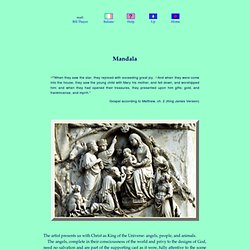
" Gospel according to Matthew, ch. 2 (King James Version) The artist presents us with Christ as King of the Universe: angels, people, and animals. Bruegel, L’Adoration des Mages. Bruegel, L’Adoration des Mages, Londres, National Gallery, 1564.
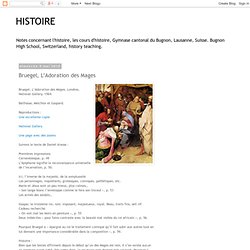
Balthasar, Melchior et Gaspard. Reproductions :Une excellente copie National Gallery Une page avec des zooms Suivons le texte de Daniel Arasse : Premières impressions Carnavalesque, p. 49 L’épiphanie signifie la reconnaissance universelle de l’Incarnation, p. 50. Ici, l’inverse de la majesté, de la somptuosité Les personnages, inquiétants, grotesques, comiques, pathétiques, etc. Gaspar, le troisième roi, noir, imposant, majestueux, royal. Pourquoi Bruegel a « épargné au roi le traitement comique qu’il fait subir aux autres tout en lui donnant une importance considérable dans la composition », p. 59. Histoire : Bien que les textes affirment depuis le début qu’un des Mages est noir, il n’en existe aucun en peinture avant 1460.
Dès 1460, le Gaspar des Adorations est habillé plus luxueusement que les autres. Plusieurs hypothèses, pp. 64-75. The Adoration of the Kings. In this unusual rendering of the Adoration, the Three Kings presenting their gifts are treated as caricatures and the Virgin is not idealised.
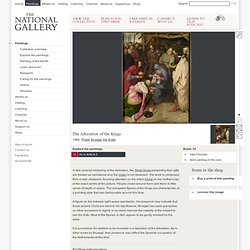
The work is composed from a high viewpoint, focusing attention on the Infant Christ on his mother's lap, at the exact centre of the picture. People crowd around them and there is little sense of depth or space. The elongated figures of the Kings are characteristic of a painting style that was fashionable around this time.
A figure on the extreme right wears spectacles. His presence may indicate that those around Christ are blind to his significance; Bruegel has used spectacles on other occasions to signify in an ironic manner the inability of the subject to see the truth. Untitled Document. Maitani Reliefs — The Annunciation. 26And in the sixth month the angel Gabriel was sent from God upon a city of Galilee, named Nazareth, 27To a virgin espoused to a man whose name was Joseph, of the house of David; and the virgin's name was Mary. 28And the angel came upon her and said, "Hail, thou that art highly favoured, the Lord is with thee: blessed art thou among women.
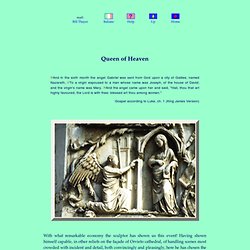
" Gospel according to Luke, ch. 1 (King James Version) With what remarkable economy the sculptor has shown us this event! Having shown himself capable, in other reliefs on the façade of Orvieto cathedral, of handling scenes most crowded with incident and detail, both convincingly and pleasingly, here he has chosen the essentials: a young woman and the bearer of extraordinary tidings. She is not surprised or frightened; interrupted at prayer or reading, she is starting to think, and despite what she hears, she remains very much in charge.
This focus on the essentials, the artist has bought at a price, or at least so it seems at first. L'Annonciation (Fra Angelico, Madrid) Eden. Maitani Reliefs — Adam and Eve. Noah Movie - "Creation" Clip. Dans quelle langue la Bible a-t-elle été écrite? Presque tous les textes de la bible ont d'abord été écrits soit en hébreu, soit en grec.
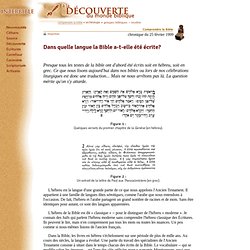
Ce que nous lisons aujourd'hui dans nos bibles ou lors de nos célébrations liturgiques est donc une traduction... Mais ne nous arrêtons pas là. La question mérite qu'on s'y attarde. Figure 1 : Quelques versets du premier chapitre de la Genèse (en hébreu). Figure 2 : Un extrait de la lettre de Paul aux Thessaloniciens (en grec). L'hébreu est la langue d'une grande partie de ce que nous appelons l'Ancien Testament. L'hébreu de la Bible est dit « classique » -- pour le distinguer de l'hébreu « moderne ». Dans la Bible, les livres en hébreu s'échelonnent sur une période de plus de mille ans. Plus de trois cents ans avant Jésus-Christ, Alexandre le Grand conquiert la « Palestine ». Le Nouveau Testament que nous connaissons vient tout entier du grec. Les communautés chrétiennes adoptent très rapidement le texte grec même pour l'Ancien Testament.